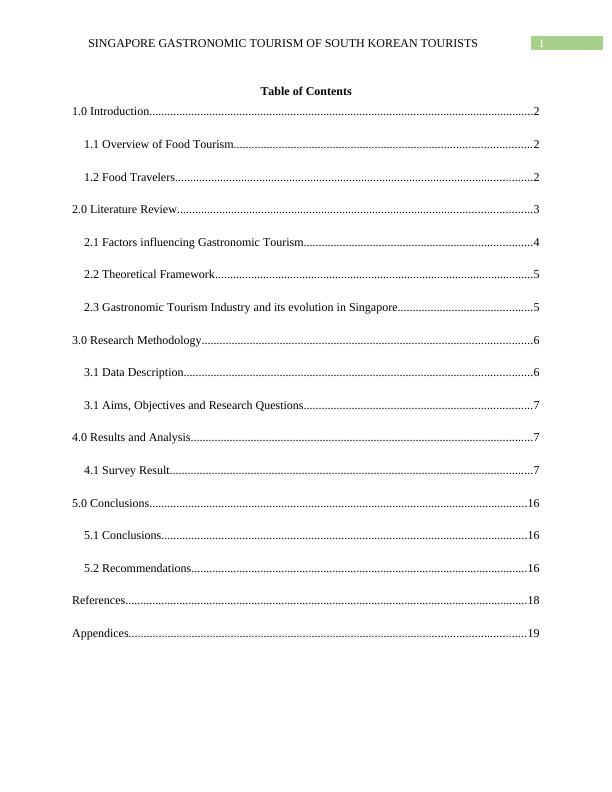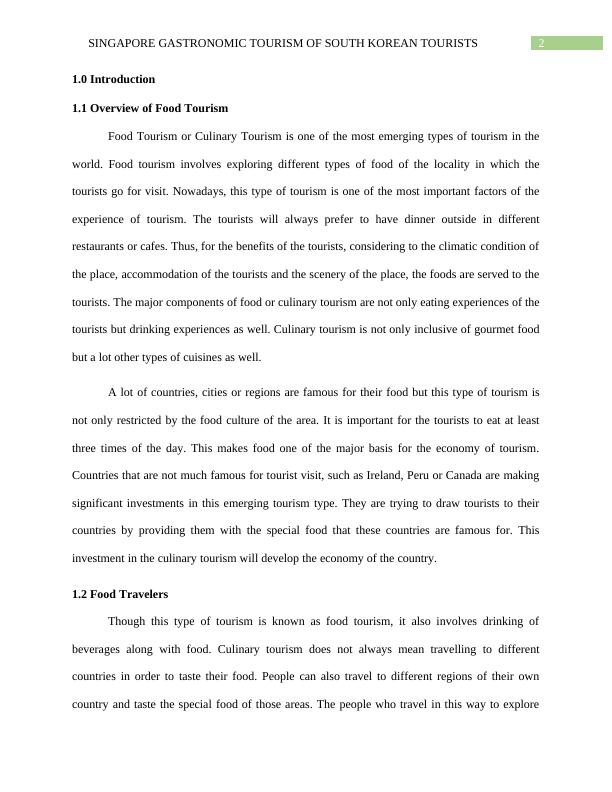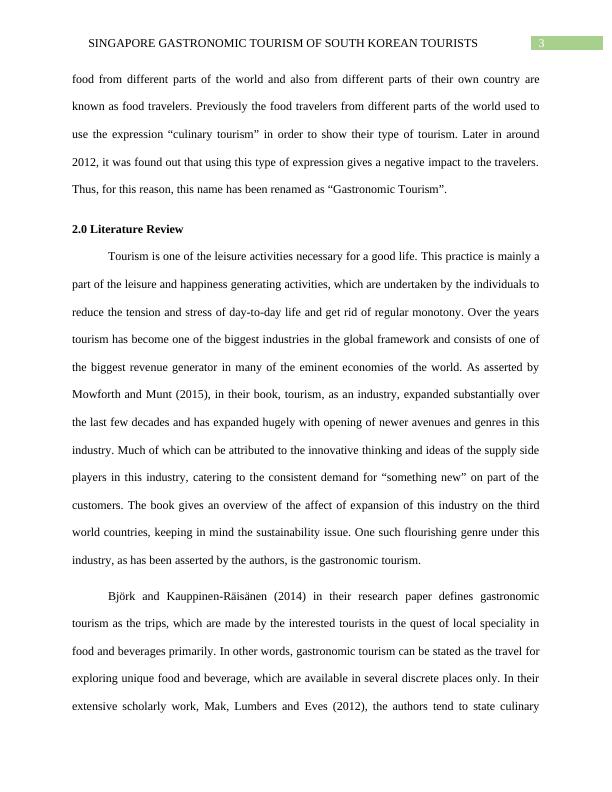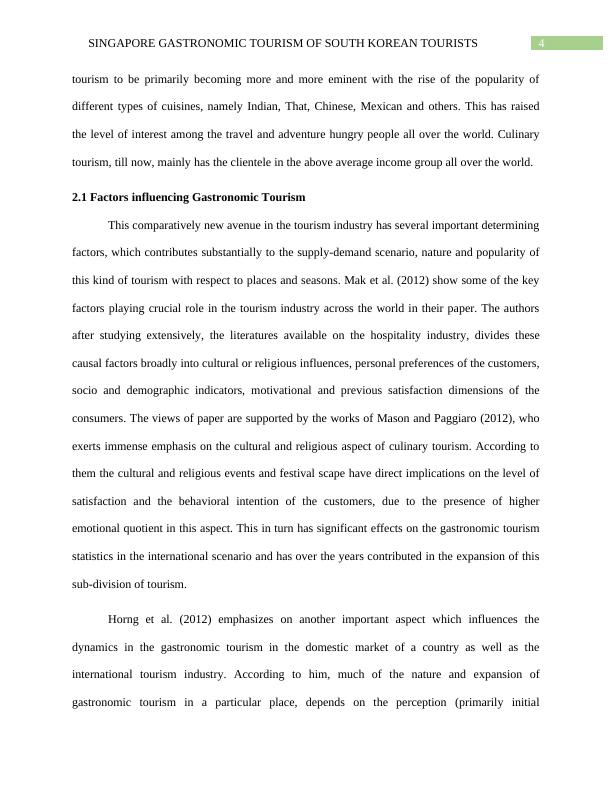Ask a question from expert
Food Tourism or Culinary Tourism Assignment
23 Pages4805 Words796 Views
Added on 2020-03-16
Food Tourism or Culinary Tourism Assignment
Added on 2020-03-16
BookmarkShareRelated Documents
Running Head: SINGAPORE GASTRONOMIC TOURISM OF SOUTH KOREAN TOURISTSSingapore Gastronomic Tourism of South Korean TouristsName of the StudentName of the UniversityAuthor Note

1SINGAPORE GASTRONOMIC TOURISM OF SOUTH KOREAN TOURISTSTable of Contents1.0 Introduction................................................................................................................................21.1 Overview of Food Tourism...................................................................................................21.2 Food Travelers.......................................................................................................................22.0 Literature Review......................................................................................................................32.1 Factors influencing Gastronomic Tourism............................................................................42.2 Theoretical Framework..........................................................................................................52.3 Gastronomic Tourism Industry and its evolution in Singapore.............................................53.0 Research Methodology..............................................................................................................63.1 Data Description....................................................................................................................63.1 Aims, Objectives and Research Questions............................................................................74.0 Results and Analysis..................................................................................................................74.1 Survey Result.........................................................................................................................75.0 Conclusions..............................................................................................................................165.1 Conclusions..........................................................................................................................165.2 Recommendations................................................................................................................16References......................................................................................................................................18Appendices....................................................................................................................................19

2SINGAPORE GASTRONOMIC TOURISM OF SOUTH KOREAN TOURISTS1.0 Introduction1.1 Overview of Food TourismFood Tourism or Culinary Tourism is one of the most emerging types of tourism in theworld. Food tourism involves exploring different types of food of the locality in which thetourists go for visit. Nowadays, this type of tourism is one of the most important factors of theexperience of tourism. The tourists will always prefer to have dinner outside in differentrestaurants or cafes. Thus, for the benefits of the tourists, considering to the climatic condition ofthe place, accommodation of the tourists and the scenery of the place, the foods are served to thetourists. The major components of food or culinary tourism are not only eating experiences of thetourists but drinking experiences as well. Culinary tourism is not only inclusive of gourmet foodbut a lot other types of cuisines as well. A lot of countries, cities or regions are famous for their food but this type of tourism isnot only restricted by the food culture of the area. It is important for the tourists to eat at leastthree times of the day. This makes food one of the major basis for the economy of tourism.Countries that are not much famous for tourist visit, such as Ireland, Peru or Canada are makingsignificant investments in this emerging tourism type. They are trying to draw tourists to theircountries by providing them with the special food that these countries are famous for. Thisinvestment in the culinary tourism will develop the economy of the country. 1.2 Food TravelersThough this type of tourism is known as food tourism, it also involves drinking ofbeverages along with food. Culinary tourism does not always mean travelling to differentcountries in order to taste their food. People can also travel to different regions of their owncountry and taste the special food of those areas. The people who travel in this way to explore

3SINGAPORE GASTRONOMIC TOURISM OF SOUTH KOREAN TOURISTSfood from different parts of the world and also from different parts of their own country areknown as food travelers. Previously the food travelers from different parts of the world used touse the expression “culinary tourism” in order to show their type of tourism. Later in around2012, it was found out that using this type of expression gives a negative impact to the travelers.Thus, for this reason, this name has been renamed as “Gastronomic Tourism”. 2.0 Literature ReviewTourism is one of the leisure activities necessary for a good life. This practice is mainly apart of the leisure and happiness generating activities, which are undertaken by the individuals toreduce the tension and stress of day-to-day life and get rid of regular monotony. Over the yearstourism has become one of the biggest industries in the global framework and consists of one ofthe biggest revenue generator in many of the eminent economies of the world. As asserted byMowforth and Munt (2015), in their book, tourism, as an industry, expanded substantially overthe last few decades and has expanded hugely with opening of newer avenues and genres in thisindustry. Much of which can be attributed to the innovative thinking and ideas of the supply sideplayers in this industry, catering to the consistent demand for “something new” on part of thecustomers. The book gives an overview of the affect of expansion of this industry on the thirdworld countries, keeping in mind the sustainability issue. One such flourishing genre under thisindustry, as has been asserted by the authors, is the gastronomic tourism. Björk and Kauppinen-Räisänen (2014) in their research paper defines gastronomictourism as the trips, which are made by the interested tourists in the quest of local speciality infood and beverages primarily. In other words, gastronomic tourism can be stated as the travel forexploring unique food and beverage, which are available in several discrete places only. In theirextensive scholarly work, Mak, Lumbers and Eves (2012), the authors tend to state culinary

4SINGAPORE GASTRONOMIC TOURISM OF SOUTH KOREAN TOURISTStourism to be primarily becoming more and more eminent with the rise of the popularity ofdifferent types of cuisines, namely Indian, That, Chinese, Mexican and others. This has raisedthe level of interest among the travel and adventure hungry people all over the world. Culinarytourism, till now, mainly has the clientele in the above average income group all over the world. 2.1 Factors influencing Gastronomic TourismThis comparatively new avenue in the tourism industry has several important determiningfactors, which contributes substantially to the supply-demand scenario, nature and popularity ofthis kind of tourism with respect to places and seasons. Mak et al. (2012) show some of the keyfactors playing crucial role in the tourism industry across the world in their paper. The authorsafter studying extensively, the literatures available on the hospitality industry, divides thesecausal factors broadly into cultural or religious influences, personal preferences of the customers,socio and demographic indicators, motivational and previous satisfaction dimensions of theconsumers. The views of paper are supported by the works of Mason and Paggiaro (2012), whoexerts immense emphasis on the cultural and religious aspect of culinary tourism. According tothem the cultural and religious events and festival scape have direct implications on the level ofsatisfaction and the behavioral intention of the customers, due to the presence of higheremotional quotient in this aspect. This in turn has significant effects on the gastronomic tourismstatistics in the international scenario and has over the years contributed in the expansion of thissub-division of tourism. Horng et al. (2012) emphasizes on another important aspect which influences thedynamics in the gastronomic tourism in the domestic market of a country as well as theinternational tourism industry. According to him, much of the nature and expansion ofgastronomic tourism in a particular place, depends on the perception (primarily initial

5SINGAPORE GASTRONOMIC TOURISM OF SOUTH KOREAN TOURISTSperception) of the tourists who are visiting this places in search of new culinary experiences. Thepaper suggests that the perception of the tourists and their typology and mental construct playsignificant role in building up the brand loyalty of a provider and the strength of this relationshipplays an important role in determining the future prospects of these providers an d the industry asa whole. 2.2 Theoretical FrameworkThe expansion of the culinary tourism, as a sister industry to the tourism as a whole, hasbeen tried to be explained by the existing theoretical framework, by several scholars, amongwhom the article by Kayat, Sharif and Karnchanan (2013), can be taken into account. Taking thebasic construct of the Maslow’s Hierarchical Need Theory in the gastronomic tourism industry,the authors try to demonstrate the effects of the satisfaction of the safety and physiological needsof the tourists, belonging needs, need for self-esteem and self-actualization of the tourists on theprospects of the culinary tourism and its expansion in future. Their arguments speak in favor ofthe presence of influence of these factors in the development of gastronomic tourism in manyparts of the country especially in the Asian countries. The stark difference in the cultural andreligious aspects in these countries, according to the authors is also drawing significant touristattractions in this form of tourism. 2.3 Gastronomic Tourism Industry and its evolution in SingaporeSingapore as a player in the global economic scenario, has come a long way in the lastfew decades and have emerged as a global economic giant. Like many other industries, thetourism industry in this country has evolved significantly and has been gaining increasingpopularity among global tourists with time. This also includes the culinary tourism. Chaney andRyan (2012) have tried to analyze the evolution of this industry over time in the economy of

End of preview
Want to access all the pages? Upload your documents or become a member.
Related Documents
Gastronomic Tourist Motivations: A Literature Reviewlg...
|10
|2724
|240
The higher consumer satisfaction levelslg...
|6
|978
|18
Food and Drink Tourism: Classification, Destination Choices, and Triple Bottom Linelg...
|12
|4122
|285
Gastronomy and Culinary Tourism: Exploring the Link with Cultural Tourismlg...
|14
|4202
|208
Culinary Tourism and its Interrelationship with Cultural Tourismlg...
|10
|3589
|178
Culinary Tourism and its Link to Cultural Tourismlg...
|12
|3428
|56